PONTIAC GRAND-AM 1993 Owners Manual
Manufacturer: PONTIAC, Model Year: 1993, Model line: GRAND-AM, Model: PONTIAC GRAND-AM 1993Pages: 306, PDF Size: 15.39 MB
Page 151 of 306
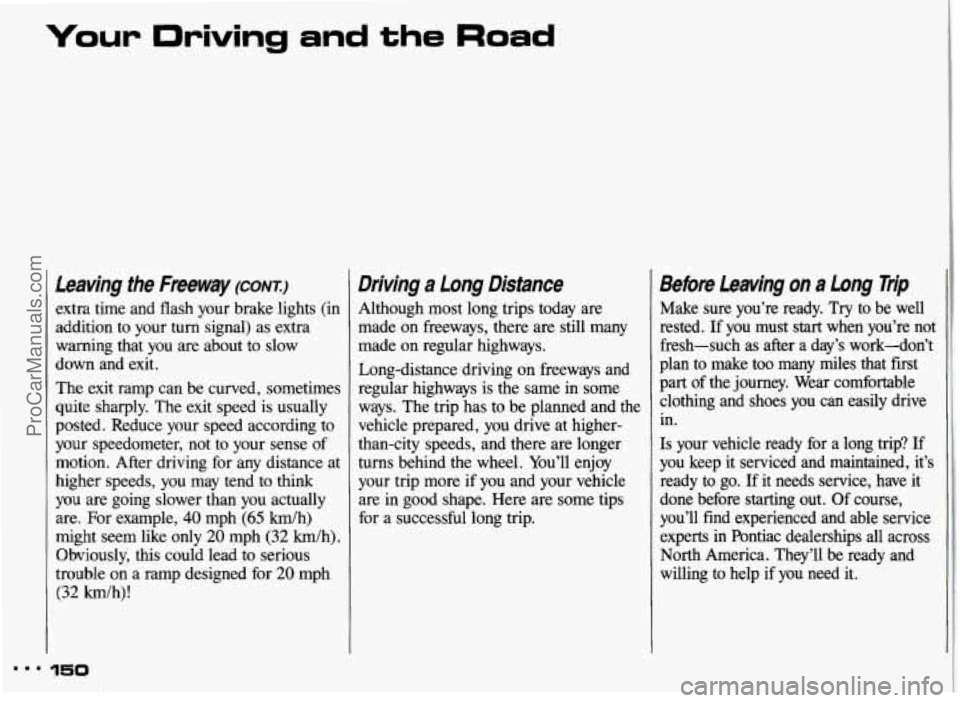
Your Driving and the Road
Leaving the Freeway (CONT.)
extra time and flash your brake lights (in
addition to your turn signal) as extra
warning that you are about to slow
down and exit.
The exit ramp can be curved, sometimes
quite sharply. The exit speed is usually
posted. Reduce your speed according to
your speedometer, not to your sense of
motion. After driving for any distance at
higher speeds, you may tend to think
you are going slower than you actually
are. For example,
40 mph (65 km/h)
might seem like only
20 mph (32 km/h).
Obviously, this could lead to serious
trouble
on a ramp designed for 20 mph
(32 km/h)!
150
Driving a Long Distance
Although most long trips today are
made on freeways, there are still many
made on regular highways.
Long-distance driving on freeways and
regular highways is the same in some
ways. The trip has to be planned and the
vehicle prepared, you drive at higher-
than-city speeds, and there are longer
turns behind the wheel. You’ll enjoy
your trip more if you and your vehicle
are in good shape. Here are some tips
for a successful long trip.
Before Leaving on a Long nip
Make sure you’re ready. Try to be well
rested.
If you must start when you’re not
fresh-such as after a
day’s work-don’t
plan to make too many miles that first
part of the journey. Wear comfortable
clothing and shoes you can easily drive
in.
Is your vehicle ready for a long trip? If
you keep it serviced and maintained, it’s
ready to go. If it needs service, have it
done before starting out. Of course,
you’ll find experienced and able service
experts in Pontiac dealerships all across
North America. They’ll be ready and willing to help if you need it.
ProCarManuals.com
Page 152 of 306
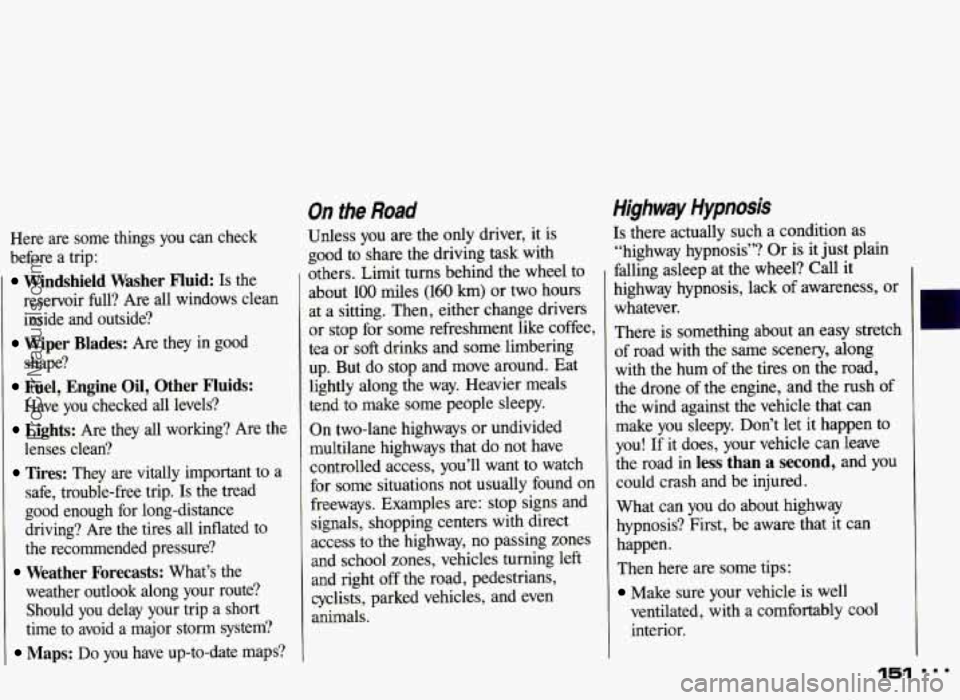
Here are some things you can check
before a trip:
Windshield Washer Fluid: Is the
reservoir full? Are all windows clean
inside and outside?
shape?
Have you checked all levels?
lenses clean?
safe, trouble-free trip.
Is the tread
good enough for long-distance
driving? Are the tires all inflated to
the recommended pressure?
weather outlook along your route? Should you delay your trip a short
time to avoid a major storm system?
Maps: Do you have up-to-date maps?
Wiper Blades: Are they in good
Fuel, Engine Oil, Other Fluids:
Lights: Are they all working? Are the
Tires: They are vitally important to a
Weather Forecasts: What’s the
On the Road
Unless you are the only driver, it is
good to share the driving task with
others. Limit
turns behind the wheel to
about
100 miles (160 km) or two hours
at a sitting. Then, either change drivers
or stop for some refreshment like coffee,
tea or
soft drinks and some. limbering
up. But do stop and move around. Eat
lightly along the way. Heavier meals
tend to make some people sleepy.
On two-lane highways or undivided
multilane highways that do not have
controlled access, you’ll want to watch
for some situations not usually found on
freeways. Examples are: stop signs and
signals, shopping centers with direct
access to the highway, no passing zones
and school zones, vehicles turning left
and right off the road, pedestrians,
cyclists, parked vehicles, and even
animals.
Highway Hypnosis
Is there actually such a condition as
“highway hypnosis”? Or is it just plain
falling asleep at the wheel?
Call it
highway hypnosis, lack of awareness, or
whatever.
There is something about an easy stretch
of road with the same scenery, along
with the hum of the tires on the road,
the drone of the engine, and the rush
of
the wind against the vehicle that can
make you sleepy. Don’t let it happen
to
you! If it does, your vehicle can leave
the road
in less than a second, and you
could crash and be injured.
What can you do about highway
hypnosis? First, be aware that it can
happen.
Then here are some tips:
Make sure your vehicle is well
ventilated, with a comfortably cool
interior.
151 ...
ProCarManuals.com
Page 153 of 306
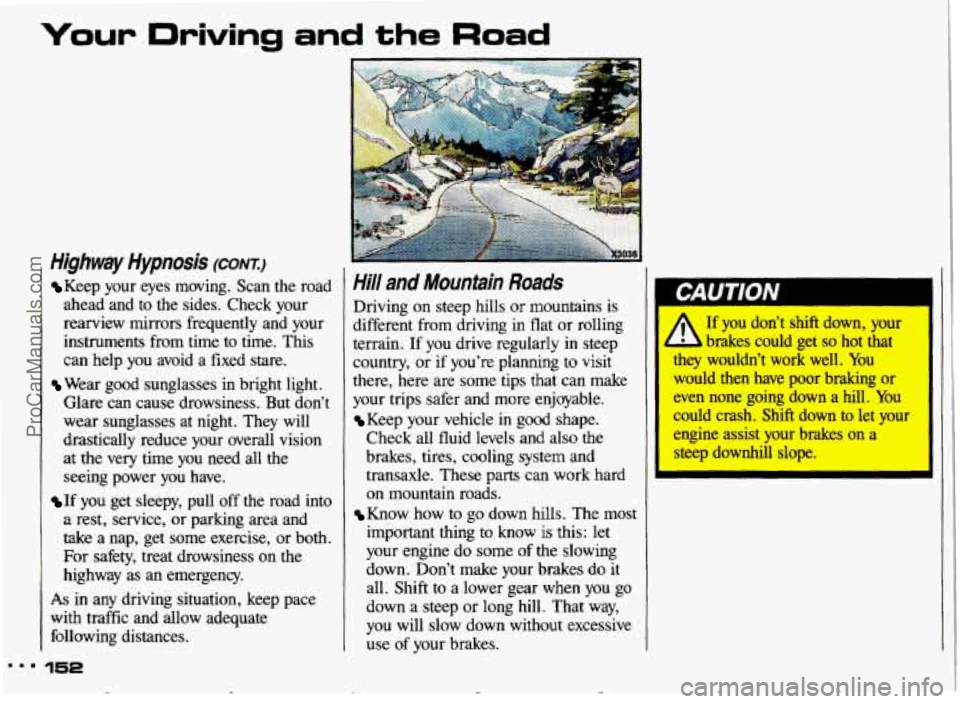
your urwlng and the Road
Highway Hypnosis (CONI)
Keep your eyes moving. Scan the road
ahead and to the sides. Check your
rearview mirrors frequently and your
instruments from time to time. This
can help you avoid a fixed stare.
Wear good sunglasses in bright light.
Glare can cause drowsiness. But don’t
wear sunglasses at night. They will
drastically reduce your overall vision
at the very time you need all the
seeing power you have.
If you get sleepy, pull off the road into
a rest, service, or parking area and
take a nap, get some exercise, or both.
For safety, treat drowsiness on the
highway as an emergency.
As in any driving situation, keep pace
with traffic and allow adequate
following distances.
I CAUTION
d
Hill and Mountain Roads
Driving on steep hills or mountains is
different from driving in flat or rolling
terrain. If
you drive regularly in steep
country, or
if you’re planning to visit
there, here are
some tips that can make
your trips safer and more enjoyable.
Keep your vehicle in good shape.
Check all fluid levels and also the
brakes, tires, cooling system and
transaxle. These parts can work hard
on mountain roads.
Know how to go down hills. The most
important thing to know
is this: let
your engine do some of the slowing
down. Don’t make your brakes
do it
all. Shift to a lower gear when
you go
down a steep or long hill. That way,
you will slow down without excessive
use of your brakes.
A
If you don’t shift down, your
brakes could get
so hot that
they wouldn’t work well.
You
would then have poor braking or
even none going down a hill. You
could crash. Shift down to let your
engine assist your brakes on
a
steep downhill slope.
ProCarManuals.com
Page 154 of 306
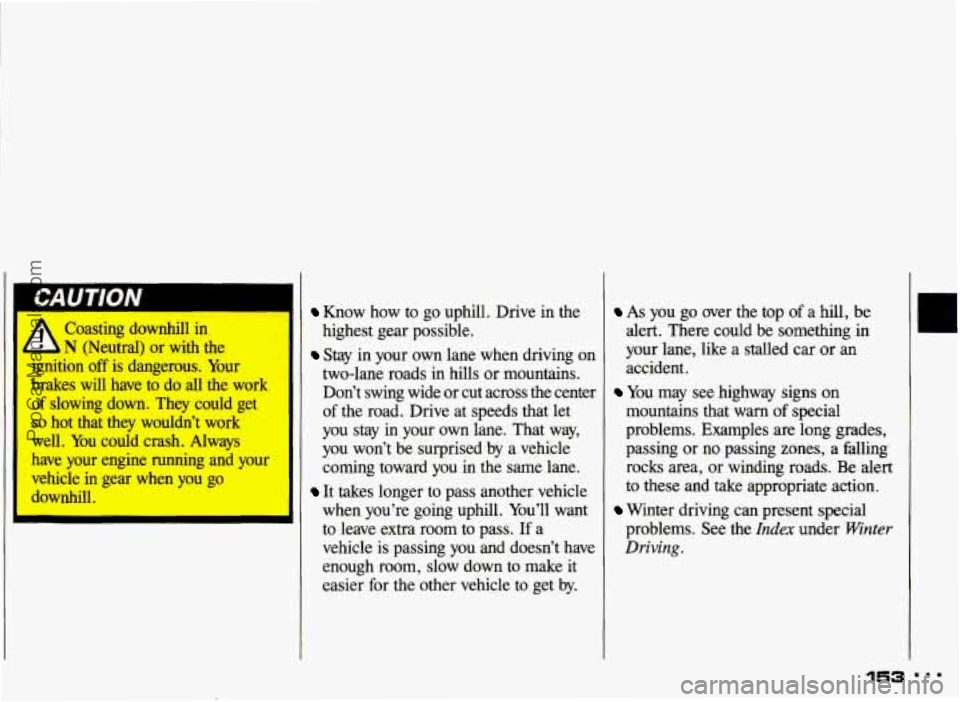
CAUTION
A
Coasting downhill in
N (Neutral) or with the
ignition
off is dangerous. Your
brakes will have to do all the work
of slowing down. They could get
so hot that they wouldn’t work
well. You could crash. Always
have your engine running and your
vehicle in gear when you go
downhill.
Know how to go uphill. Drive in the
highest gear possible.
Stay in your own lane when driving on
two-lane roads in hills or mountains.
Don’t swing wide or cut across the center
of the road. Drive at speeds that let
you stay in your own lane. That way,
you won’t be surprised by a vehicle
coming toward you
in the same lane.
It takes longer to pass another vehicle
when you’re going uphill. You’ll want
to leave extra room to pass. If a
vehicle
is passing you and doesn’t have
enough room, slow down to make it
easier- for the other vehicle to get by.
As you go over the top of a hill, be
alert. There could be something in
your lane, like a stalled
car or an
accident.
You may see highway signs on
mountains that warn of special
problems. Examples are long grades,
passing or no passing zones, a falling
rocks area, or winding roads.
Be alert
to these and take appropriate action.
problems. See the
Index under Winter
Driving.
Winter driving can present special
153
ProCarManuals.com
Page 155 of 306
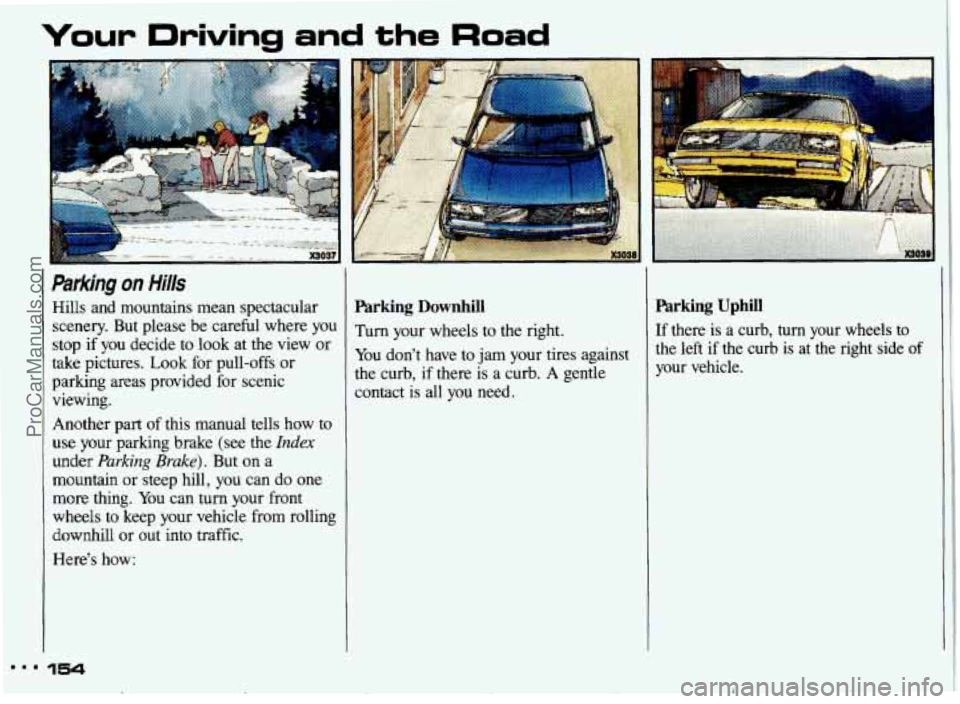
Your Driving and the Road
parking on Hills
Hills and mountains mean spectacular
scenery. But please be careful where you
stop if you decide to look at the view or
take pictures. Look for pull-offs or
parking areas provided for scenic
viewing.
Another part
of this manual tells how to
use your parking brake (see the
Index
under Parking Brake). But on a
mountain or steep hill, you can do one
more thing. You can turn your front
wheels to keep your vehicle from rolling
downhill or out into traffic.
Here's how:
Parking Downhill
Turn your wheels to the right.
You don't have to jam your tires against
the curb, if there is
a curb. A gentle
contact is all you need.
Parking Uphill
If there is a curb, turn your wheels to
the left if the curb is at the right side of
your vehicle.
ProCarManuals.com
Page 156 of 306
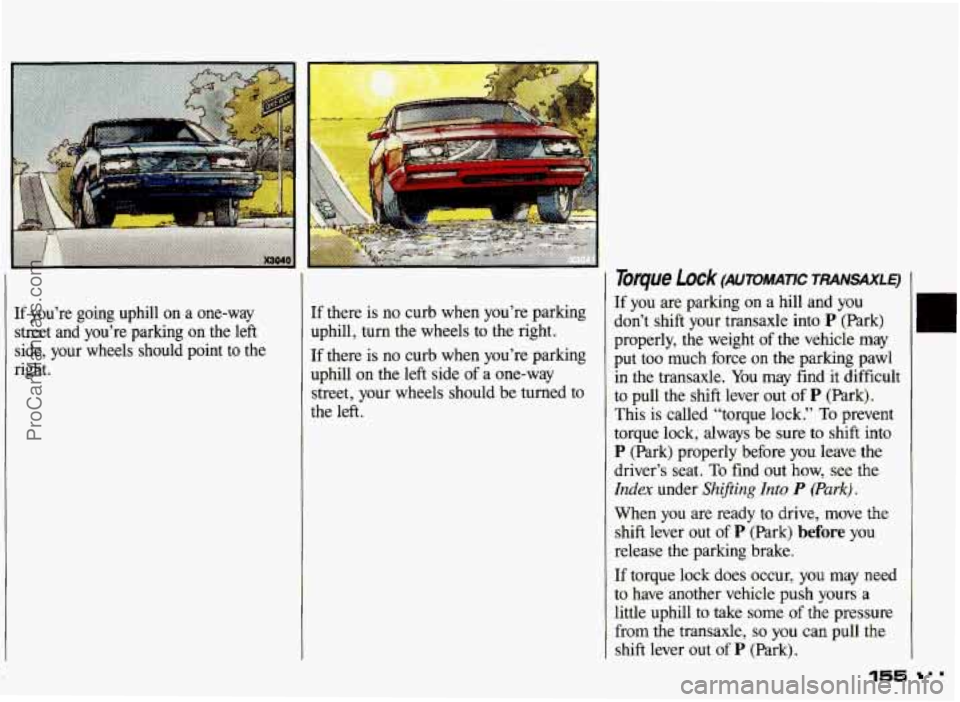
If you’re going uphill on a one-way
uphill,
turn the wheels to the right.
street and you’re parking on the left
If there is no curb when you’re parking
uphill on the left side
of a one-way right.
If there is no curb when you’re parking
side, your wheels should point to the
street, your wheels should
be turned to
the left:
Toque Lock (AUTOMATN: rtunsAxLq
If you are parking on a hill and you
don’t shift your transaxle into
P (Park)
properly, the weight of the vehicle may
put too much force on the parking pawl
in the transaxle. You may find it difficult
to pull the shift lever out
of P (Park).
This is called “torque lock,” To prevent
torque lock, always be sure
to shift into
P (Park) properly before you leave the
driver’s seat. To find out how, see the
Index under Shifting Into P (Park).
When you are ready to drive, move the
shift lever out
of P (Park) before you
release the parking brake.
If torque lock does occur, you may need
to have another vehicle push yours a
little uphill to take some
of the pressure
from the transaxle, so you can pull the
shift lever out of P (Park).
c
155
ProCarManuals.com
Page 157 of 306
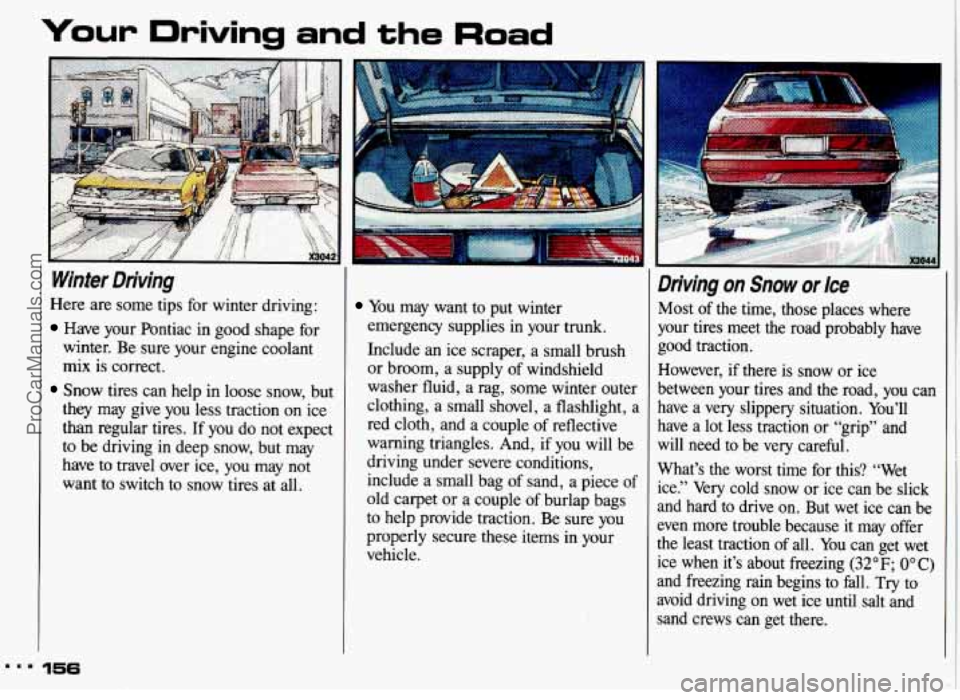
Your Driving and the Road
Winter Driving
Here are some tips for winter driving:
Have your Pontiac in good shape for
winter. Be sure your engine coolant
mix is correct.
Snow tires can help in loose snow, but
they may give you less traction on ice
than regular tires. If you do not expect
to be driving in deep snow, but may
have to travel over ice, you may not
want to switch to snow tires at all.
.a. 156
You may want to put winter
emergency supplies in your trunk.
Include an ice scraper, a small brush
or broom, a supply of windshield
washer fluid, a rag, some winter outer
clothing, a small shovel, a flashlight, a
red cloth, and a couple of reflective
warning triangles. And, if
you will be
driving under severe conditions,
include a small bag of sand, a piece of
old carpet or a couple of burlap bags
to help provide traction. Be sure you
properly secure these items in your
vehicle.
Driving on Snow or Ice
Most of the time, those places where
your tires meet the road probably have
good traction.
However, if there is snow or ice
between your tires and
the road, you can
have a very slippery situation. You’ll
have a lot less traction
or “grip” and
will need to be very careful.
What’s the
worst time for this? “Wet
ice.” Very cold snow or ice can be slick
and hard to drive on. But wet ice can be
even more trouble because it may offer
the least traction of all. You can get wet
ice when it’s about freezing
(32°F; OOC)
and freezing rain begins to fall. Try to
avoid driving on wet ice until salt and
sand crews can get there.
ProCarManuals.com
Page 158 of 306
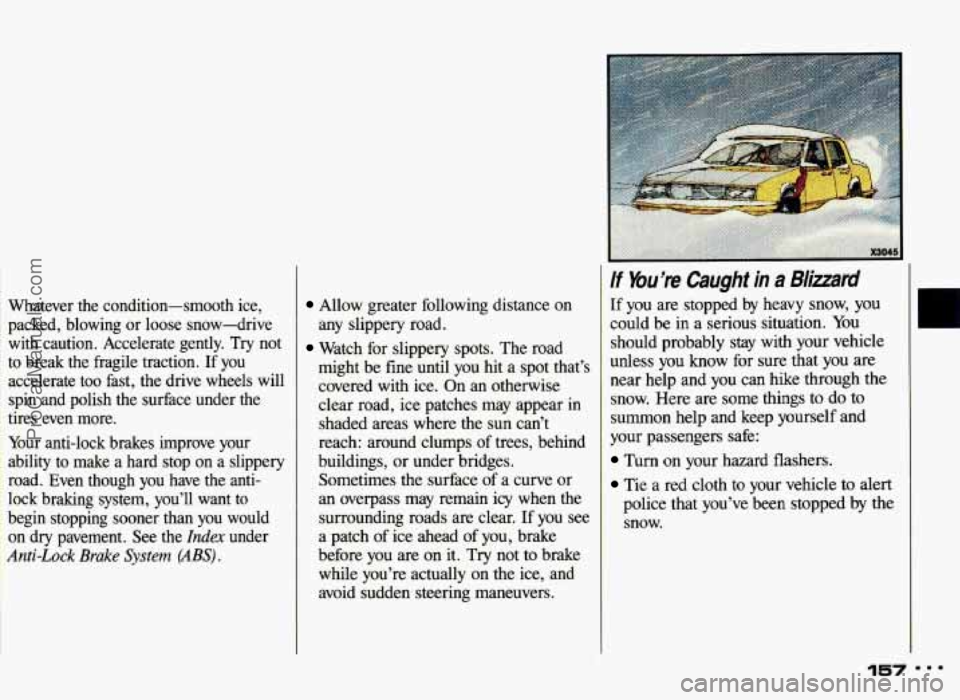
Whatever the condition-smooth ice,
packed, blowing or loose snow-drive with caution. Accelerate gently. Try not
to break the fragile traction. If you
accelerate too fast, the drive wheels will spin and polish the surface under the
tires even more.
Your anti-lock brakes improve your
ability
to make a hard stop on a slippery
road. Even though you have the anti-
lock braking system, you’ll want to
begin stopping sooner than you would on dry pavement. See the
Idex under
1 Anti-Lock Brake System (ABS).
Allow greater following distance on
any slippery road.
Watch for slippery spots. The road
might be fine until you hit a spot that’s
covered with ice. On an otherwise
clear road, ice patches may appear in
shaded areas where the
sun can’t
reach: around clumps of trees, behind
buildings, or under bridges.
Sometimes the surface of a curve or
an overpass may remain icy when the
surrounding roads are clear. If you see
a patch
of ice ahead of you, brake
before you are on it.
Try not to brake
while you’re actually on the ice, and
avoid sudden steering maneuvers.
If You’re Caught in a Blizzard
If you are stopped by heavy snow, you
could be in a serious situation.
You
should probably stay with your vehicle
unless you know for sure that you are
near help and you can hike through the
snow. Here are some
things to do to
summon help and keep yourself and
your passengers safe:
Turn on your hazard flashers.
Tie a red cloth to your vehicle to alert
police that you’ve been stopped by the
snow.
157
ProCarManuals.com
Page 159 of 306
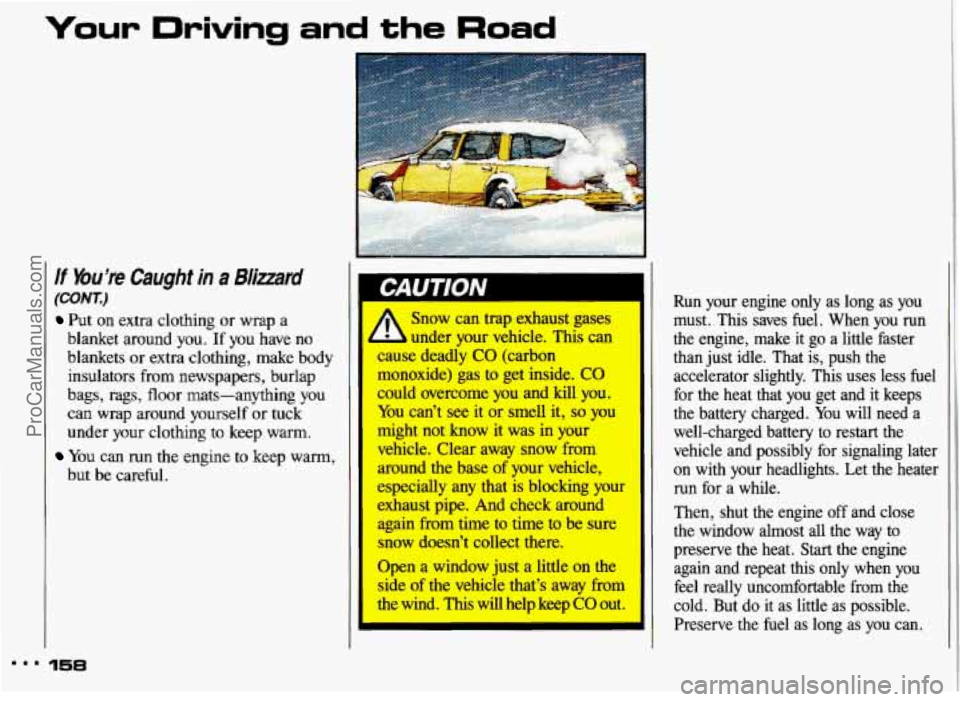
lf bu’re Caught in a Bliuard
(CONZ)
Put on extra clothing or wrap a
blanket around you.
If you have no
blankets or extra clothing, make body
insulators from newspapers, burlap
bags, rags, floor mats-anything you
can wrap around yourself or tuck
under your clothing to keep warm.
You can run the engine to keep warm,
but be careful.
158
cause deadly CO (carbon
monoxide) gas to get inside.
CO
could overcome you and kill you.
You can’t see it or smell it,
so you
might not know it was
in your
vehicle. Clear away snow from
around the base of your vehicle,
especially any that
is blocking your
exhaust pipe. And check around
again from time to time to be sure
snow doesn’t collect there.
Open a window just a little on the
side
of the vehicle that’s away from
the wind.
This will help keep CO out. Run your engine only as long as you
must. This saves fuel. When you
run
the engine, make it go
a little faster
than just idle. That is, push the
accelerator slightly. This uses less fuel
for the heat that you get and it keeps
the battery charged. You will need a
well-charged battery to restart the
vehicle and possibly for signaling later
on with your headlights.
Let the heater
run for a while.
Then, shut the engine off and close
the window almost all the way to
preserve the heat.
Start the engine
again and repeat this only when you
feel really uncomfortable from the
cold. But do it as little as possible.
Preserve the fuel as long as you can.
ProCarManuals.com
Page 160 of 306
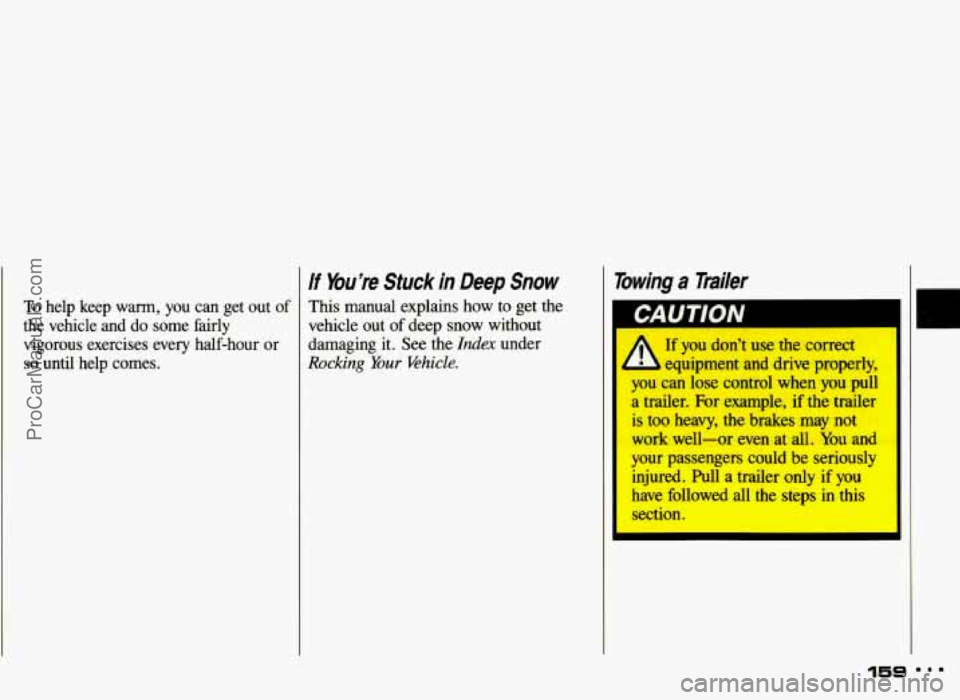
To help keep warm, you can get out of
the vehicle and do some fairly
vigorous exercises every half-hour or
so until help comes.
If You're Stuck in Deep Snow
This manual explains how to get the
vehicle out of deep snow without
damaging it. See the
Index under
Rocking Your Ehicle.
Towing a nailer
A
If you don't use the correct
equipment and drive properly,
you can lose control when you pull
a trailer. For example, if the trailer
is too heavy, the brakes may not
work well-or even at
all. You and
your passengers could be seriously
injured. Pull a trailer
only if you
have followed all the steps in
this
section.
I
ProCarManuals.com